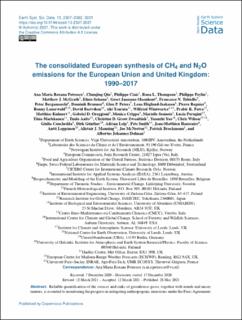| dc.contributor.author | Petrescu, Ana Maria Roxana | |
| dc.contributor.author | Qiu, Chunjing | |
| dc.contributor.author | Ciais, Philippe | |
| dc.contributor.author | Thompson, Rona Louise | |
| dc.contributor.author | Peylin, Philippe | |
| dc.contributor.author | McGrath, Matthew J | |
| dc.contributor.author | Solazzo, Efisio | |
| dc.contributor.author | Janssens-Maenhout, Greet | |
| dc.contributor.author | Tubiello, Francesco N. | |
| dc.contributor.author | Bergamaschi, Peter | |
| dc.contributor.author | Brunner, Dominik | |
| dc.contributor.author | Peters, Glen Philip | |
| dc.contributor.author | Hoglund-Isaksson, Lena | |
| dc.contributor.author | Regnier, Pierre | |
| dc.contributor.author | Lauerwald, Ronny | |
| dc.contributor.author | Bastviken, David | |
| dc.contributor.author | Tsuruta, Aki | |
| dc.contributor.author | Winiwarter, Wilfried | |
| dc.contributor.author | Patra, Prabir K. | |
| dc.contributor.author | Kuhnert, Matthias | |
| dc.contributor.author | Oreggioni, Gabriel David | |
| dc.contributor.author | Crippa, Monica | |
| dc.contributor.author | Saunois, Marielle | |
| dc.contributor.author | Perugini, Lucia | |
| dc.contributor.author | Markkanen, Tiina | |
| dc.contributor.author | Aalto, Tuula | |
| dc.contributor.author | Zwaaftink, Christine Groot | |
| dc.contributor.author | Yao, Yuanzhi | |
| dc.contributor.author | Wilson, Chris | |
| dc.contributor.author | Conchedda, Giulia | |
| dc.contributor.author | Günther, Dirk | |
| dc.contributor.author | Leip, Adrian | |
| dc.contributor.author | Smith, Pete | |
| dc.contributor.author | Haussaire, Jean-Matthieu | |
| dc.contributor.author | Leppänen, Antti | |
| dc.contributor.author | Manning, Alistair J. | |
| dc.contributor.author | McNorton, Joe | |
| dc.contributor.author | Brockmann, Patrick | |
| dc.contributor.author | Dolman, Albertus Johannes | |
| dc.date.accessioned | 2021-06-08T07:13:34Z | |
| dc.date.available | 2021-06-08T07:13:34Z | |
| dc.date.created | 2021-06-01T10:43:05Z | |
| dc.date.issued | 2021 | |
| dc.identifier.citation | Earth System Science Data. 2021, 13, 2307-2362. | en_US |
| dc.identifier.issn | 1866-3508 | |
| dc.identifier.uri | https://hdl.handle.net/11250/2758403 | |
| dc.description.abstract | Reliable quantification of the sources and sinks of greenhouse gases, together with trends and uncertainties, is essential to monitoring the progress in mitigating anthropogenic emissions under the Paris Agreement. This study provides a consolidated synthesis of CH4 and N2O emissions with consistently derived state-of-the-art bottom-up (BU) and top-down (TD) data sources for the European Union and UK (EU27 + UK). We integrate recent emission inventory data, ecosystem process-based model results and inverse modeling estimates over the period 1990–2017. BU and TD products are compared with European national greenhouse gas inventories (NGHGIs) reported to the UN climate convention UNFCCC secretariat in 2019. For uncertainties, we used for NGHGIs the standard deviation obtained by varying parameters of inventory calculations, reported by the member states (MSs) following the recommendations of the IPCC Guidelines. For atmospheric inversion models (TD) or other inventory datasets (BU), we defined uncertainties from the spread between different model estimates or model-specific uncertainties when reported. In comparing NGHGIs with other approaches, a key source of bias is the activities included, e.g., anthropogenic versus anthropogenic plus natural fluxes. In inversions, the separation between anthropogenic and natural emissions is sensitive to the geospatial prior distribution of emissions. Over the 2011–2015 period, which is the common denominator of data availability between all sources, the anthropogenic BU approaches are directly comparable, reporting mean emissions of 20.8 Tg CH4 yr−1 (EDGAR v5.0) and 19.0 Tg CH4 yr−1 (GAINS), consistent with the NGHGI estimates of 18.9 ± 1.7 Tg CH4 yr−1. The estimates of TD total inversions give higher emission estimates, as they also include natural emissions. Over the same period regional TD inversions with higher-resolution atmospheric transport models give a mean emission of 28.8 Tg CH4 yr−1. Coarser-resolution global TD inversions are consistent with regional TD inversions, for global inversions with GOSAT satellite data (23.3 Tg CH4 yr−1) and surface network (24.4 Tg CH4 yr−1). The magnitude of natural peatland emissions from the JSBACH–HIMMELI model, natural rivers and lakes emissions, and geological sources together account for the gap between NGHGIs and inversions and account for 5.2 Tg CH4 yr−1. For N2O emissions, over the 2011–2015 period, both BU approaches (EDGAR v5.0 and GAINS) give a mean value of anthropogenic emissions of 0.8 and 0.9 Tg N2O yr−1, respectively, agreeing with the NGHGI data (0.9 ± 0.6 Tg N2O yr−1). Over the same period, the average of the three total TD global and regional inversions was 1.3 ± 0.4 and 1.3 ± 0.1 Tg N2O yr−1, respectively. The TD and BU comparison method defined in this study can be operationalized for future yearly updates for the calculation of CH4 and N2O budgets both at the EU+UK scale and at the national scale. The referenced datasets related to figures are visualized at https://doi.org/10.5281/zenodo.4590875 (Petrescu et al., 2020b) | en_US |
| dc.language.iso | eng | en_US |
| dc.rights | Navngivelse 4.0 Internasjonal | * |
| dc.rights.uri | http://creativecommons.org/licenses/by/4.0/deed.no | * |
| dc.title | The consolidated European synthesis of CH4 and N2O emissions for the European Union and United Kingdom: 1990–2017 | en_US |
| dc.type | Peer reviewed | en_US |
| dc.type | Journal article | en_US |
| dc.description.version | publishedVersion | en_US |
| dc.rights.holder | © Author(s) 2021. | en_US |
| dc.source.pagenumber | 2307-2362 | en_US |
| dc.source.volume | 13 | en_US |
| dc.source.journal | Earth System Science Data | en_US |
| dc.identifier.doi | 10.5194/essd-13-2307-2021 | |
| dc.identifier.cristin | 1912990 | |
| dc.relation.project | EC/H2020/725546 | en_US |
| dc.relation.project | EC/H2020/809596 | en_US |
| dc.relation.project | EC/H2020/776186 | en_US |
| dc.relation.project | Norges forskningsråd: 245927 | en_US |
| dc.relation.project | NILU - Norsk institutt for luftforskning: 116006 | en_US |
| dc.relation.project | NILU - Norsk institutt for luftforskning: 118014 | en_US |
| cristin.ispublished | true | |
| cristin.fulltext | original | |
| cristin.qualitycode | 1 | |

